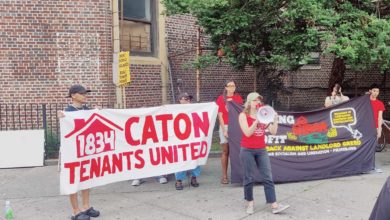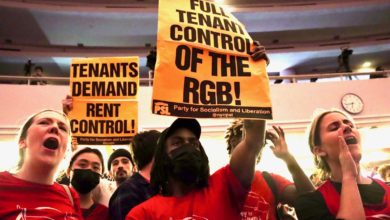How can the Occupy movement grow this winter in the country’s hardest-hit communities? Just ask the family of Alfredo Carrasquillo and Tasha Glasgow, who on Dec. 6 were moved into a previously foreclosed–now “re-occupied”–home in the East New York neighborhood of Brooklyn.
Hundreds of protesters marched through the rain in East New York to demand an end to evictions and foreclosures. Stopping periodically at empty homes along the way, at each location, a victim of predatory lending told their story of how they lost their home through no fault of their own. Some had lived in their homes for 10 and even 20 years.
Carrasquillo and Glasgow had been relying on the help of friends and neighbors after being evicted from their home several years ago. Glasgow had been awarded a Section 8 voucher so she and her children could move out of the shelter system and into a home. In the latest round of budget cuts, however, her voucher was taken away and she no longer had an option for her family. The home that they are now occupying was foreclosed on by Bank of America over three years ago. The community had been maintaining the property and allowing other homeless people to stay there. Protesters brought housewarming gifts with them to welcome the Carrasquillo and Glasgow family into their new home.
As the powerful chanting resonated through the streets, community members began to come out and see what was happening, with many joining in the march.
While the corporate media calls the Occupy movement “unfocused,” the message of these protesters was clear: everyone deserves the right to a home. Howard Bostick, a local barber, said, “I think this is great. We have people sleeping on the sidewalk but here we have an empty home that could be occupied.”
Although there were only four official stops on the “foreclosure tour,” protesters marched past many empty properties. Foreclosure rates in East New York are three times the rate of the rest of Brooklyn and five times the rate of the rest of the state.
The foreclosure crisis disproportionately affects nationally oppressed communities. According to a report released by ACORN, African American homebuyers were 2.7 times more likely to be issued a high-cost loan than white buyers. Latino buyers were 2.3 times more likely than white buyers. These trends, and the high overall foreclosure rate, are not likely to change unless a major struggle is waged against the banks and titans of the capitalist housing industry.
Organizers made it clear that this was just the beginning of occupations in homes across the cities. Protester Mike Vaughn said, “It is obviously unfair that the banks got bailed out, they have money for all these wars, yet the people that lost their homes get no help.”





